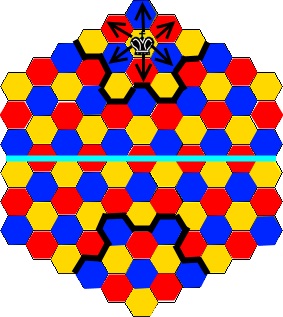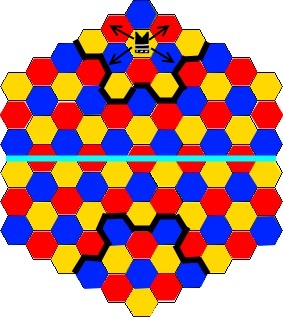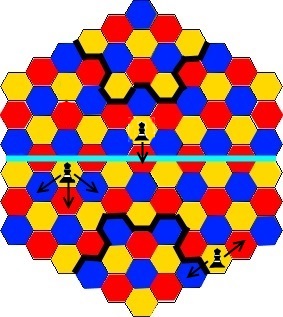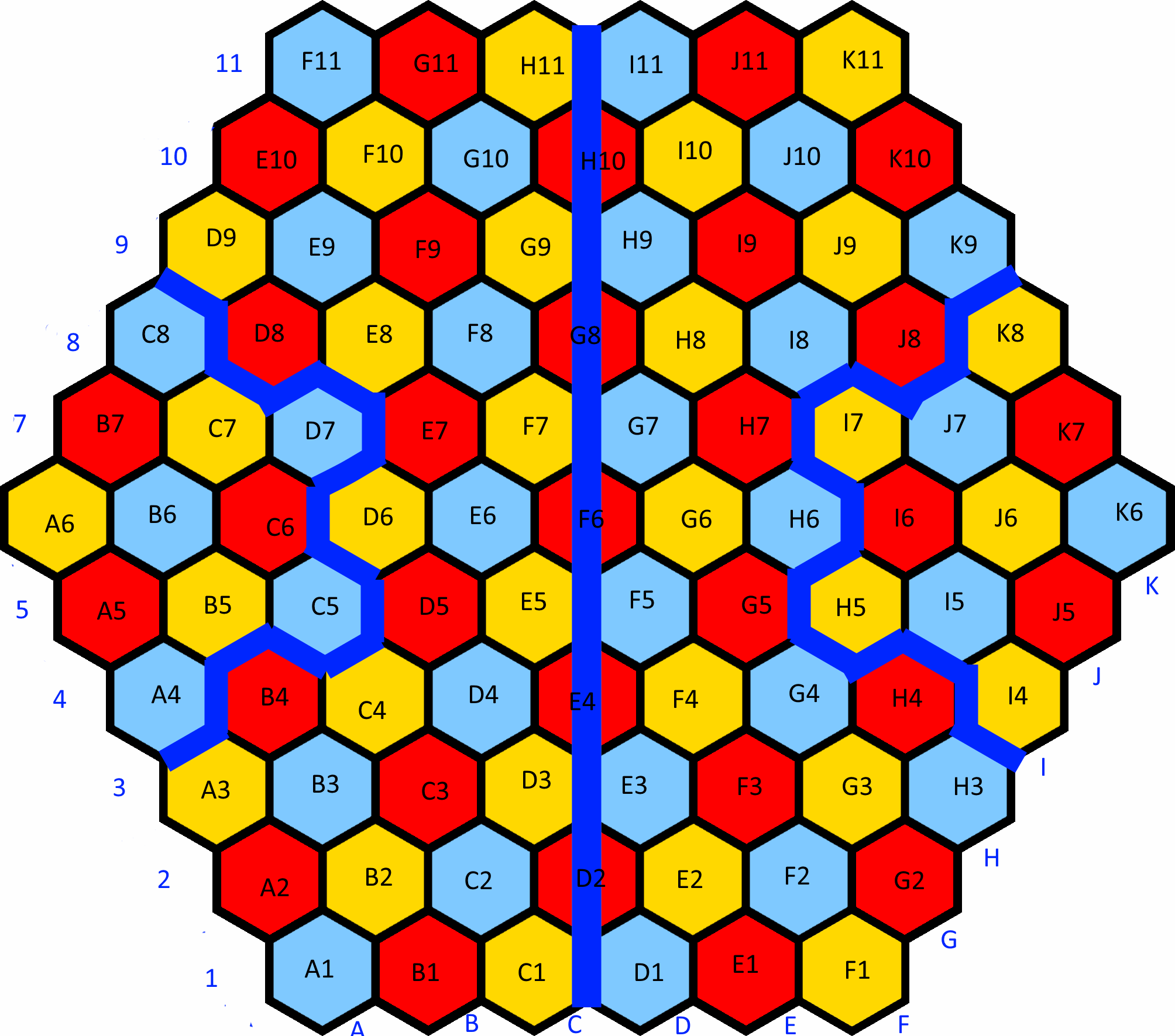Hexiang Qi
Played on a board of 91 hexagonal spaces as shown below. The pieces are similar to Xiang Qi, with moves as shown. There is an extra piece, the Banner, which moves something like a Chess Bishop. Soldiers ( Pawns ) move one space forward until they have crossed the central river ( blue line ), after which they can also move diagonally forwards. On reaching the last row they are not promoted, but can move backwards or forwards along the last row.
Setup

Pieces
BANNER The Banner moves along the X-oriented spaces ( 60 or 120 degree angles ) as shown for any distance which is unobstructed.
CANNON
The Banner moves along the X-oriented spaces ( 60 or 120 degree angles ) as shown for any distance which is unobstructed.
CANNON The Cannon moves orthogonally for any distance which is unobstructed. It can also move along the X-oriented spaces ( 60 or 120 degree angles ) one space only, but does not capture on such moves.
The Cannon has a unique method of capture; it requires a “screen†piece located between itself and the opponent's piece along the same rank or file. The Cannon jumps over the screen onto the space occupied by the opponent's piece. The screen can be either a friendly or opposing piece, but there must be only one screen piece, it cannot jump over more than one piece.
CHARIOT
The Cannon moves orthogonally for any distance which is unobstructed. It can also move along the X-oriented spaces ( 60 or 120 degree angles ) one space only, but does not capture on such moves.
The Cannon has a unique method of capture; it requires a “screen†piece located between itself and the opponent's piece along the same rank or file. The Cannon jumps over the screen onto the space occupied by the opponent's piece. The screen can be either a friendly or opposing piece, but there must be only one screen piece, it cannot jump over more than one piece.
CHARIOT The Chariot moves in orthogonal directions for any distance which is unobstructed. It can also move one space only along the X-oriented spaces ( 60 or 120 degree angles ).
ELEPHANT
The Chariot moves in orthogonal directions for any distance which is unobstructed. It can also move one space only along the X-oriented spaces ( 60 or 120 degree angles ).
ELEPHANT The Elephant moves as shown above to one of the six nearest spaces of the same colour. It can not be blocked by any piece on the adjacent spaces. Elephants can not enter or cross the river and are therefore restricted to a limited number of spaces of the same colour.
HORSE
The Elephant moves as shown above to one of the six nearest spaces of the same colour. It can not be blocked by any piece on the adjacent spaces. Elephants can not enter or cross the river and are therefore restricted to a limited number of spaces of the same colour.
HORSE The Horse's move is through any adjacent space for two steps, followed by one step at a 60 degree angle. If an adjacent space is occupied, the Horse is blocked in that direction, however it can “jump†any piece on the second step of its move. There are potentially 12 spaces to which an unobstructed Horse can move.
KING
The Horse's move is through any adjacent space for two steps, followed by one step at a 60 degree angle. If an adjacent space is occupied, the Horse is blocked in that direction, however it can “jump†any piece on the second step of its move. There are potentially 12 spaces to which an unobstructed Horse can move.
KING The King or General can move to any adjacent space within the Palace ( indicated by the thick black lines ). Thus it is restricted to 11 spaces of the board. Note also that the King may never move to a space controlled by an opponent's piece, and the two Kings may never face each other along an unobstructed file,
ADVISER
The King or General can move to any adjacent space within the Palace ( indicated by the thick black lines ). Thus it is restricted to 11 spaces of the board. Note also that the King may never move to a space controlled by an opponent's piece, and the two Kings may never face each other along an unobstructed file,
ADVISER The Adviser or Mandarin may move one space along the X-oriented spaces ( 60 or 120 degree angles ) within the Palace only.
SOLDIER
The Adviser or Mandarin may move one space along the X-oriented spaces ( 60 or 120 degree angles ) within the Palace only.
SOLDIER The Soldier moves one space directly forwards until it is on or has crossed the River, after which it can also move forwards at a 60 degree angle. On reaching the last row it is not promoted, but can move backwards or forwards along the last row.
All pieces capture in the same way as they move, except the Cannon which must jump over one piece ( friend or enemy ) to capture the next piece beyond.
The Soldier moves one space directly forwards until it is on or has crossed the River, after which it can also move forwards at a 60 degree angle. On reaching the last row it is not promoted, but can move backwards or forwards along the last row.
All pieces capture in the same way as they move, except the Cannon which must jump over one piece ( friend or enemy ) to capture the next piece beyond.
Rules
Kings can not move to any space controlled by the enemy, nor can they face each other along an open file. If a player has no legal move { Stalemate ), they lose. Perpetual checking or chasing is a draw.
Notes
At the beginning of the game, the Soldiers on files 4 and 8 are under attack by the opponent's Cannons, but are protected by the Elephant and front Banner. An exchange of a Cannon for a Soldier would be a very disadvantageous move. As there are only 2 Elephants per side, no Elephant can ever access spaces of the 3rd colour, which is the colour of the spaces crossed by the River. APPROXIMATE RELATIVE POWERS OF THE PIECES [ Attacking strength only, defensive attributes not included ] CHARIOT 18 BANNER 18 CANNON 15 HORSE 12 ELEPHANT 6 KING 6 ADVISER 4 SOLDIER** 3 ( ** After crossing the River ) SOLDIER 2 ( Average ) SOLDIER# 1 ( # Before crossing the River ) MOVE NOTATION :
Identification of the pieces is as follows :
K = King, A = Mandarin, E = Elephant, H = Horse, R = Chariot, C = Cannon, B = Banner, P = Soldier.
Moves are recorded using XiangQi style notation, eg P4+D, this indicates that the Red Soldier on file 4 moves forward to diagonal rank D. The corresponding move by Black would be p8+H. The symbols used are + ( moves forward ), - ( moves backward ), = ( moves 90 degrees laterally ), x ( captures ), * ( check ) and ## ( checkmate ). Red's pieces are shown in capitals, Black's in lower case. If the movement ends on the same file as the starting cell, the destination is specified by its rank letter. If the movement ends on a different file, the file number of the destination is shown. When there are two or more identical pieces on the same file, they are identified by their starting cell coordinates. Unlike XiangQi notation, the files and diagonal ranks are indexed from Red's side of the board only.
Game Example
1 P4+D p8+H 16 RB3+D p6+F
2 H9+8 r10+9 17 P2+C c4+C (xE)
3 BC6+2 c8+I 18 C5+I (xa) e7=5 (xE)
4 C8+9 p6+G 19 H4+5 (xb) k6+5 (xH)
5 H8+7 c8-7 20 RD3=9 (xh) c4=8 (xP)
6 H7+4 (xp) h3+4 21 B6+2 e5+6
7 B2+5 h9+11 22 R9+K c8-7
8 R10+11 r9=11 23 B2+6 c7+D (xC)
9 E5+4 bJ6-5 24 R3=5 b6+8
10 C4+5 h4+3 25 B6+7 e6-5
11 R2+3 h3-5 (xB) 26 B6+2 (xr) * eH5-4
12 R11+I h5-7 27 R9+8 (xa) h2+5 (xR)
13 E8+7 h7-4 28 B2+4 (xe) ##
14 R11=5 h2-4
15 R5=3 h11+9
MOVE NOTATION :
Identification of the pieces is as follows :
K = King, A = Mandarin, E = Elephant, H = Horse, R = Chariot, C = Cannon, B = Banner, P = Soldier.
Moves are recorded using XiangQi style notation, eg P4+D, this indicates that the Red Soldier on file 4 moves forward to diagonal rank D. The corresponding move by Black would be p8+H. The symbols used are + ( moves forward ), - ( moves backward ), = ( moves 90 degrees laterally ), x ( captures ), * ( check ) and ## ( checkmate ). Red's pieces are shown in capitals, Black's in lower case. If the movement ends on the same file as the starting cell, the destination is specified by its rank letter. If the movement ends on a different file, the file number of the destination is shown. When there are two or more identical pieces on the same file, they are identified by their starting cell coordinates. Unlike XiangQi notation, the files and diagonal ranks are indexed from Red's side of the board only.
Game Example
1 P4+D p8+H 16 RB3+D p6+F
2 H9+8 r10+9 17 P2+C c4+C (xE)
3 BC6+2 c8+I 18 C5+I (xa) e7=5 (xE)
4 C8+9 p6+G 19 H4+5 (xb) k6+5 (xH)
5 H8+7 c8-7 20 RD3=9 (xh) c4=8 (xP)
6 H7+4 (xp) h3+4 21 B6+2 e5+6
7 B2+5 h9+11 22 R9+K c8-7
8 R10+11 r9=11 23 B2+6 c7+D (xC)
9 E5+4 bJ6-5 24 R3=5 b6+8
10 C4+5 h4+3 25 B6+7 e6-5
11 R2+3 h3-5 (xB) 26 B6+2 (xr) * eH5-4
12 R11+I h5-7 27 R9+8 (xa) h2+5 (xR)
13 E8+7 h7-4 28 B2+4 (xe) ##
14 R11=5 h2-4
15 R5=3 h11+9
 This 'user submitted' page is a collaboration between the posting user and the Chess Variant Pages. Registered contributors to the Chess Variant Pages have the ability to post their own works, subject to review and editing by the Chess Variant Pages Editorial Staff.
This 'user submitted' page is a collaboration between the posting user and the Chess Variant Pages. Registered contributors to the Chess Variant Pages have the ability to post their own works, subject to review and editing by the Chess Variant Pages Editorial Staff.
By Robert Hancock.
Web page created: 2016-02-27. Web page last updated: 2016-02-27
